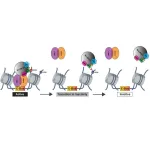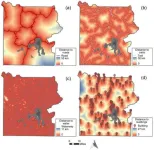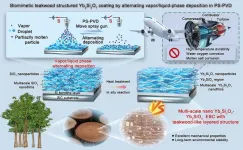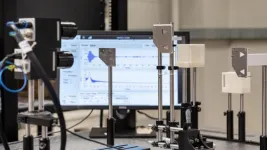(Press-News.org) BUSHLAND, Texas, Jan. 8, 2025 –A new study from USDA’s Agricultural Research Service (ARS) and Iowa State University (ISU) reveals that generative Artificial Intelligence (AI) can help expedite the search for solutions to reduce enteric methane emissions caused by cows in animal agriculture, which accounts for about 33 percent of U.S. agriculture and 3 percent of total U.S. greenhouse gas emissions.
"Developing solutions to address methane emissions from animal agriculture is a critical priority. Our scientists continue to use innovative and data-driven strategies to help cattle producers achieve emission reduction goals that will safeguard the environment and promote a more sustainable future for agriculture," said ARS Administrator Simon Liu.
One of these innovative solutions starts in the cow’s stomach, where microorganisms contribute to enteric fermentation and cause cows to belch methane as part of normal digestion processes. The team of scientists found a group of compound molecules capable of inhibiting methane production in the largest of the cow’s four stomach compartments, the rumen, which can be tested to help mitigate methane emissions.
One molecule in particular, bromoform, which is naturally found in seaweed, has been identified by the scientific community to demonstrate properties that can result in reducing cattle enteric methane production by 80-98 percent when fed to cattle. Unfortunately, bromoform is known to be a carcinogen, limiting its potential use in cattle for food safety reasons. Therefore, scientists continue to search for molecules with similar potential to inhibit enteric methane. However, this type of research presents challenges of being especially time-consuming and expensive.
In response to these challenges, a team of scientists at the ARS Livestock Nutrient Management Research Unit and ISU’s Department of Chemical and Biological Engineering combined generative AI with large computational models to jumpstart the quest for bromoform-like molecules that can do the same job without toxicity.
"We are using advanced molecular simulations and AI to identify novel methane inhibitors based on the properties of previously investigated inhibitors [like bromoform], but that are safe, scalable, and have a large potential to inhibit methane emissions,” said Matthew Beck, a research animal scientist working with ARS at the time the study was completed and is now with Texas A&M University’s Department of Animal Science. "Iowa State University is leading the computer simulation and AI work, while ARS is taking the lead in identifying compounds and truth testing them using a combination of in vitro [laboratory] and in vivo [live cattle] studies."
Publicly available databases that contained scientific data collected from previous studies on the cows’ rumen were used to build large computational models. AI, along with these models, was used to predict the behavior of molecules and to identify those that can be further tested in a laboratory. The results from the laboratory tests feed the computer models for AI to make more accurate predictions, creating a feedback loop process known as a graph neural network.
"Our graph neural network is a machine learning model, which learns the properties of molecules, including details of the atoms and the chemical bonds that hold them, while retaining useful information about the molecules' properties to help us study how they are likely to behave in the cow's stomach," said ISU Assistant Professor Ratul Chowdhury. "We studied their biochemical fingerprint to identify what makes them do the job successfully as opposed to the other fifty thousand molecules that are lurking around in the cow’s rumen but don’t actively stop the production of methane."
"This study successfully demonstrated that fifteen molecules cluster very close to each other in what we call a ‘functional methanogenesis inhibition space,’ meaning they seem to contain the same enteric methane inhibition potential, chemical similarity, and cell permeability as bromoform," added Chowdhury.
Scientists believe AI can play a significant role in understanding how known molecules interact with both proteins and the microbial community of the rumen and thereby discover novel molecules and potentially key interactions within the rumen microbiome. This type of predictive modeling can be particularly helpful for animal nutritionists.
"There are other promising strategies currently available to mitigate enteric methane emissions, but the available solutions are relatively limited," said USDA-ARS Research Leader Jacek Koziel. "This is why combining AI with laboratory research, through iterative refinement, is a valuable scientific tool. AI can fast-forward the research and accelerate these several pathways that animal nutritionists, researchers, and companies can pursue to get us closer to a very ambitious goal of limiting greenhouse gas emissions and helping mitigate climate change."
The study also presents a total computational and monetary cost breakdown to conduct this research on a per molecule basis. This analysis was conducted to show an estimate of potential costs and foreseeable pitfalls of this research. This estimate can be used to guide decision-making on investments for this type of research to be done entirely in a laboratory.
Chowdhury, Beck, and Koziel are co-authors in the paper published in Animal Frontiers, along with Nathan Frazier (ARS) and Logan Thompson (Kansas State University). Mohammed Sakib Noor, an ISU graduate student, is working with Chowdhury to develop the graph neural networks.
The Agricultural Research Service is the U.S. Department of Agriculture's chief scientific in-house research agency. Daily, ARS focuses on solutions to agricultural problems affecting America. Each dollar invested in U.S. agricultural research results in $20 of economic impact.
###
USDA is an equal opportunity provider, employer, and lender.
END
A collaborative effort between Mount Sinai and Memorial Sloan Kettering Cancer Center has shed valuable light on how monoamine neurotransmitters such as serotonin, dopamine, and now histamine help regulate brain physiology and behavior through chemical bonding of these monoamines to histone proteins, the core DNA-packaging proteins of our cells.
By uncovering how these histone modifications influence the brain, the team has identified a novel mechanism for controlling circadian gene expression and behavioral rhythms. ...
Researchers have unearthed two fossils, named Punk and Emo, revealing that ancient molluscs were more complex and adaptable than previously known.
Molluscs are one of life’s most diverse animal groups and analysis of the rare 430 million year old fossils is challenging long-held views on their early origins.
The fossils dating from the Silurian period were retrieved from Herefordshire and shed light on the molluscs’ complex evolutionary history and how they moved.
The discovery challenges the longstanding ...
People who live close to airports and are exposed to high aircraft noise levels could be at greater risk of poor heart function, increasing the likelihood of heart attacks, life-threatening heart rhythms and strokes, according to a new study led by UCL (University College London) researchers.
The study, published in the Journal of the American College of Cardiology (JACC), looked at detailed heart imaging data from 3,635 people who lived close to four major airports in England.
Within this group, the research team compared the hearts of those who lived in areas with higher aircraft noise with those who lived in lower aircraft noise areas.
They found that those who lived in ...
Deans of the University of Nottingham Visited Korea University's College of Medicine
Korea University's College of Medicine Dean, Sung Bom Pyun, and Deans of the University of Nottingham; successfully held a researcher meeting program for 2 days from November 11th to 12th.
Fuve representative deans visited the University of Korea: Professor Claire Stewart, the Dean and Head of the School of Medicine at the University of Nottingham; Professor Nigel Mongan, Professor Alan McIntyre, Professor Srinivasan Madhusudan, and Professor Victoria James. They joined the program to conduct a tour and meeting with Korea University's researchers.
On ...
Standing dead trees in Yellowstone National Park are growing wildfire hazards, especially near park infrastructure. A new study published in Forest Ecosystems explores how these dead trees contribute to fire risk and threaten roads, buildings, and trails.
Dead trees, particularly those that remain standing, are a significant fire hazard. These trees—often caused by pests, diseases, and climate change—create a large amount of dry, combustible material. As temperatures rise and droughts intensify, the risk of wildfires increases, making it essential to understand how dead trees contribute to fire danger.
The team used a random forest classification model, a powerful ...
The widely used nickel-based superalloys for turbine engine materials showed a limited-service temperature of only 1200℃, and did not exceed 1500℃ even when coated with thermal barrier coatings, which is urgent to develop the advanced thermal protection system for turbine engines with higher thrust-weight ratios. Niobium alloy coated with silicide coating is undoubtedly considered the most efficient method to reach long-term service, since it can form a dense SiO2 layer with self-healing ability at high temperatures. However, the single silicide coating has a strong tendency to crack vertically ...
The Centers for Disease Control and Prevention (CDC) has selected University of California San Diego as one of three partner institutions to establish a groundbreaking pandemic preparedness initiative, the Community and Household Acute Respiratory Illness Monitoring (CHARM) Network. The new five-year cooperative agreement will help generate information on how respiratory viruses spread and provide insights into factors impacting susceptibility to respiratory illnesses. At UC San Diego, the cooperative agreement supports the $5.7 million project, “PREVENT: Preparedness through Respiratory Virus Epidemiology and Community Engagement” led by Louise Laurent, M.D., Ph.D., ...
The core message of the article is that researchers have developed an innovative technology in plasma spraying-physical vapor deposition known as alternating vapor/liquid phase deposition. By adjusting the arc current, researchers can finely control the evaporation and deposition of SiO2, and through a heat treatment process, achieve in-situ reactions that optimize the composition, structure, and nanoscale dimensions of the coating, creating an orderly arranged multi-layered teak-like biomimetic structure within it. They have conducted an in-depth analysis of the complex deposition mechanisms involved in this process. This new teak-like biomimetic structure coating is expected ...
Researchers have found a low-power, inexpensive way for large numbers of devices, such as machines in factories and equipment in labs, to share information by efficiently using signals at untapped high frequencies.
The technology could immediately enable low-cost, efficient real-time monitoring in industrial settings, such as tracking the condition of manufacturing robots or detecting gas leaks in refineries, by eliminating the need for power-hungry signal transmitters. The researchers said that with some engineering improvements, the technology ...
SPOKANE, Wash.—Elderberry juice may be a potent tool for weight management and enhancing metabolic health, according to a recent Washington State University-led study.
A clinical trial published in the journal Nutrients found that drinking 12 ounces of elderberry juice daily for a week causes positive changes in the gut microbiome and improves glucose tolerance and fat oxidation.
Elderberry, a small dark purple berry found on elder trees native to Europe, is commonly used as a medicinal plant and supplement to promote immune function. Its other potential health benefits are poorly understood, however.
“Elderberry ...





